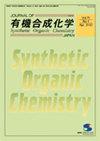炭素-窒素不斉軸を有するアトロプ異性キナゾリノンの化学
IF 0.2
4区 化学
Q4 CHEMISTRY, ORGANIC
Journal of Synthetic Organic Chemistry Japan
Pub Date : 2023-10-01
DOI:10.5059/yukigoseikyokaishi.81.978
引用次数: 0
Abstract
Recently, atropisomers owing to the rotational restriction around an N-C single bond (N-C axially chiral compounds) have received much attention in the field of synthetic organic chemistry. In particular, the catalytic enantioselective synthesis of various N-C axially chiral compounds and their application to asymmetric reactions have been reported by many groups. Bioactive compounds possessing an N-C axially chiral structure have also been known. The typical example of such bioactive N-C axially chiral compounds is quinazolin-4-one derivatives bearing an ortho-substituted phenyl group at 3-position. However, the catalytic asymmetric synthesis of N-C axially chiral quinazlolin-4-one derivatives has never been reported. We succeeded in the enantioselective synthesis of 3-(2-bromophenyl)quinazolin-4-one derivatives (GABA agonist, mebroqualone derivatives) through chiral Pd-catalyzed reductive asymmetric desymmetrization with 3-(2,6-dibromophenyl)quinazolin-4-ones. Furthermore, it was found that the reaction of various alkyl halides with the enolate prepared from quinazolinone products proceeds in a highly diastereoselective manner by the asymmetric induction due to the N-C axial chirality. The self-disproportionation of enantiomers (SDE) and crystal structure (chirality-dependent halogen bond) in mebroqualone derivatives, the preparation of N-C axially chiral quinazolinones bearing an ortho-fluorophenyl group, and the creation of isotopic atropisomers based on N-C axially chiral quinazolinone scaffold are also described.具有碳氮不对称轴的阿托普异构喹唑酮化学
近年来,由于围绕一个N-C单键的旋转限制而形成的对映异构体(N-C轴向手性化合物)在合成有机化学领域受到了广泛的关注。特别是各种N-C轴向手性化合物的催化对映选择性合成及其在不对称反应中的应用已被许多研究小组报道。具有N-C轴向手性结构的生物活性化合物也已被发现。这种具有生物活性的N-C轴向手性化合物的典型例子是在3位上含有邻取代苯基的喹唑啉-4- 1衍生物。然而,催化不对称合成N-C轴手性喹唑啉-4- 1衍生物尚未见报道。我们通过手性pd催化3-(2,6-二溴苯基)喹唑啉-4-酮的还原不对称脱对称,成功地对映选择性合成了3-(2-溴苯基)喹唑啉-4-酮衍生物(GABA激动剂,甲溴喹酮衍生物)。此外,由于N-C轴向手性的不对称诱导,各种烷基卤化物与喹唑啉酮产物制备的烯醇酯的反应具有高度的非对映选择性。本文还介绍了甲溴喹酮衍生物中对映体(SDE)和晶体结构(手性依赖卤素键)的自歧化,含邻氟苯基的N-C轴向手性喹唑啉酮的制备,以及基于N-C轴向手性喹唑啉酮支架的同位素异位异构体的制备。
本文章由计算机程序翻译,如有差异,请以英文原文为准。
求助全文
约1分钟内获得全文
求助全文
来源期刊
CiteScore
0.30
自引率
0.00%
发文量
120
审稿时长
6-12 weeks
期刊介绍:
Information not localized

 求助内容:
求助内容: 应助结果提醒方式:
应助结果提醒方式:


